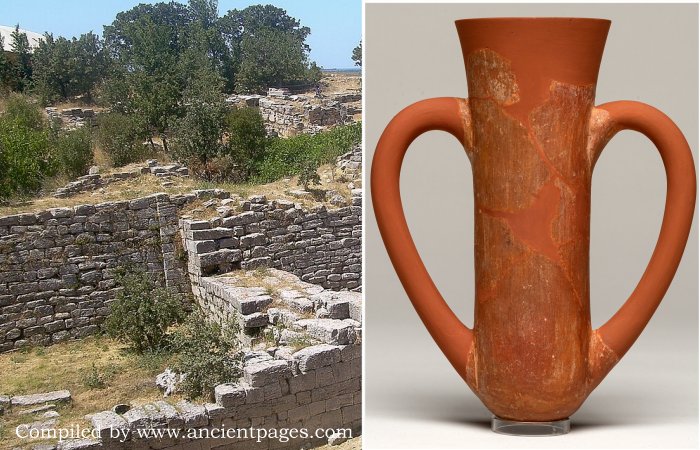Jan Bartek – AncientPages.com – For the first time, researchers have uncovered chemical evidence confirming that wine was consumed in Troy. This supports a hypothesis by Heinrich Schliemann, who discovered the ancient city in the 19th century. This study, conducted by teams from the Universities of Tübingen, Bonn, and Jena, reveals that wine consumption was not limited to Trojan elites but also enjoyed by ordinary citizens.
Left: Walls of Troy. Credit: CherryX – CC BY-SA 3.0 – Right: Depas goblet, excavated by Heinrich Schliemann, 15 cm high, collection of classical archaeology. Credit: University of Tübingen. Image compilation AncientPages.com
“Hephaestus spoke, then stood up, passed a double goblet across to his dear mother,” says the first book of the Iliad, recounting how the god of fire, metalworking and volcanoes encourages his mother. “As he spoke, the white-armed goddess Hera smiled. She reached for her son’s goblet. He poured the drink, going from right to left, for all the other gods, drawing off sweet nectar from the mixing bowl.”
The depas goblet, also known as the depas amphikypellon, is a familiar artifact to archaeologists. This slender clay drinking vessel ranges from twelve to forty centimeters in height and features two handles with a pointed base.
Over one hundred of these goblets have been discovered in Troy, dating back to between 2500 and 2000 BCE. Additionally, they are found across regions from the Aegean to Asia Minor and Mesopotamia. These vessels have a capacity ranging from 0.25 to 1 liter.
“Heinrich Schliemann already conjectured that the depas goblet was passed around at celebrations – just as described in the Iliad,” says Dr. Stephan Blum from the Institute of Prehistory, Early History and Medieval Archaeology at the University of Tübingen, who is a co-author of the study.
The classical archaeology collection of the University of Tübingen holds a depas goblet and two fragments from Schliemann’s trove. Maxime Rageot from the University of Bonn milled a two gram sample from the two fragments. Then he heated the samples to 380 degrees centigrade and studied the resulting mixture using gas chromatography (GC) and mass spectronomy (GC-MS).
“The evidence of succinic and pyruvic acids was conclusive: they only occur when grape juice ferments. So now we can state with confidence that wine was actually drunk from the depas goblets and not just grape juice,” says Maxime Rageot from the University of Bonn.
In the Bronze Age, wine was considered the most costly beverage, and the depas goblet was regarded as the most valuable vessel for its consumption. These goblets have been discovered in temple and palace complexes, leading scientists to conclude that wine drinking occurred during special occasions among elite groups. This raises an intriguing question: did individuals from lower classes in Troy also partake in wine as a regular part of their diet or as a luxury?
“We’ve also chemical studied ordinary cups that were found in the outer settlement of Troy and therefore outside the citadel. These vessels also contained wine!” says Stephan Blum from the University of Tübingen in a press release. “So it is clear that wine was an everyday drink for the common people too.”
See also: More Archaeology News
“Research into Troy has a long tradition at the University of Tübingen, and I am delighted that we have been able to add another piece to the puzzle revealing the picture of Troy,” says Professor Dr. Dr. h.c. (Dōshisha) Karla Pollmann, President of the University of Tübingen. The excavations at Troy (Turkish: Hisarlık) were headed by the University of Tübingen from 1987 to 2012. Currently, the excavation results are being evaluated and further analyses carried out on the material findings.
Written by Jan Bartek – AncientPages.com Staff Writer









